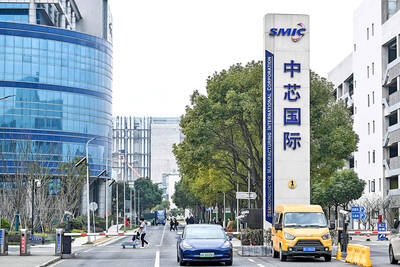MediaTek Inc (聯發科) yesterday projected that revenue this quarter would dip by 7 to 13 percent to between NT$130.1 billion and NT$140 billion (US$4.38 billion and US$4.71 billion), compared with NT$150.37 billion last quarter, which it attributed to subdued front-loading demand and unfavorable foreign exchange rates.
The Hsinchu-based chip designer said that the forecast factored in the negative effects of an estimated 6 percent appreciation of the New Taiwan dollar against the greenback.
“As some demand has been pulled into the first half of the year and resulted in a different quarterly pattern, we expect the third quarter revenue to decline sequentially,” MediaTek chief executive officer Rick Tsai (蔡力行) told an online investors’ conference.

Photo: Annabelle Chih, Bloomberg
Even so, MediaTek plans to roll out more new products to boost revenue growth this quarter, including a new flagship mobile phone chip, the Dimensity 9500 series, and a GB10 chip that it is codeveloping with Nvidia Corp for the US firms’ DGX Spark artificial intelligence (AI) supercomputers.
The company is also working with Nvidia on C-X1, a computer hub integrated with Nvidia’s Blackwell chips.
The project would start to contribute revenue next year, Tsai said.
Investors asked about MediaTek’s progress in developing its first application-specific IC (ASIC) used in data centers amid concerns about potential delays.
MediaTek downplayed the concerns, saying that its goal is to make revenue of US$1 billion from its ASIC business next year.
“We believe our customers are doing well in their tape-out progress. In addition, we are also engaging with cloud service providers” (CSPs), Tsai said.
The global AI ASIC market is estimated at US$40 billion in the mid-to-long term, thanks to rising demand for custom chips from CSPs, he said.
MediaTek expects full-year revenue this year to expand at an annual rate of 15 percent — assuming no foreign exchange rate effects — as supply chain inventory is returning to healthy levels.
By segment, revenue from its flagship mobile phone chips would expand at an annual pace of 40 percent to US$3 billion this year and connectivity chips such as Wi-Fi 7 chips would also grow to US$3 billion, MediaTek said.
Revenue from chips used in tablets and computers would surge 80 percent annually to US$1 billion, it said.
MediaTek expects a strong NT dollar to weaken its gross margin with each 1 percent appreciation of local currency to reduce its gross margin by 0.2 percentage points.
As a result, gross margin this quarter is to drop to between 45.5 and 48.5 percent, compared with 49.1 percent last quarter, it said.
The company’s net profit in the second quarter declined 5 percent to NT$27.85 billion, compared with NT$29.33 billion in the first quarter. That represented an annual growth of 8.3 percent from NT$25.72 billion.
Earnings per share were NT$17.5, compared with NT$18.43 in the previous quarter and NT$16.19 in the second quarter last year.

NO BREAKTHROUGH? More substantial ‘deliverables,’ such as tariff reductions, would likely be saved for a meeting between Trump and Xi later this year, a trade expert said China launched two probes targeting the US semiconductor sector on Saturday ahead of talks between the two nations in Spain this week on trade, national security and the ownership of social media platform TikTok. China’s Ministry of Commerce announced an anti-dumping investigation into certain analog integrated circuits (ICs) imported from the US. The investigation is to target some commodity interface ICs and gate driver ICs, which are commonly made by US companies such as Texas Instruments Inc and ON Semiconductor Corp. The ministry also announced an anti-discrimination probe into US measures against China’s chip sector. US measures such as export curbs and tariffs

The US on Friday penalized two Chinese firms that acquired US chipmaking equipment for China’s top chipmaker, Semiconductor Manufacturing International Corp (SMIC, 中芯國際), including them among 32 entities that were added to the US Department of Commerce’s restricted trade list, a US government posting showed. Twenty-three of the 32 are in China. GMC Semiconductor Technology (Wuxi) Co (吉姆西半導體科技) and Jicun Semiconductor Technology (Shanghai) Co (吉存半導體科技) were placed on the list, formally known as the Entity List, for acquiring equipment for SMIC Northern Integrated Circuit Manufacturing (Beijing) Corp (中芯北方積體電路) and Semiconductor Manufacturing International (Beijing) Corp (中芯北京), the US Federal Register posting said. The

India’s ban of online money-based games could drive addicts to unregulated apps and offshore platforms that pose new financial and social risks, fantasy-sports gaming experts say. Indian Prime Minister Narendra Modi’s government banned real-money online games late last month, citing financial losses and addiction, leading to a shutdown of many apps offering paid fantasy cricket, rummy and poker games. “Many will move to offshore platforms, because of the addictive nature — they will find alternate means to get that dopamine hit,” said Viren Hemrajani, a Mumbai-based fantasy cricket analyst. “It [also] leads to fraud and scams, because everything is now

MORTGAGE WORRIES: About 34% of respondents to a survey said they would approach multiple lenders to pay for a home, while 29.2% said they would ask family for help New housing projects in Taiwan’s six special municipalities, as well as Hsinchu city and county, are projected to total NT$710.65 billion (US$23.61 billion) in the upcoming fall sales season, a record 30 percent decrease from a year earlier, as tighter mortgage rules prompt developers to pull back, property listing platform 591.com (591新建案) said yesterday. The number of projects has also fallen to 312, a more than 20 percent decrease year-on-year, underscoring weakening sentiment and momentum amid lingering policy and financing headwinds. New Taipei City and Taoyuan bucked the downturn in project value, while Taipei, Hsinchu city and county, Taichung, Tainan and Kaohsiung